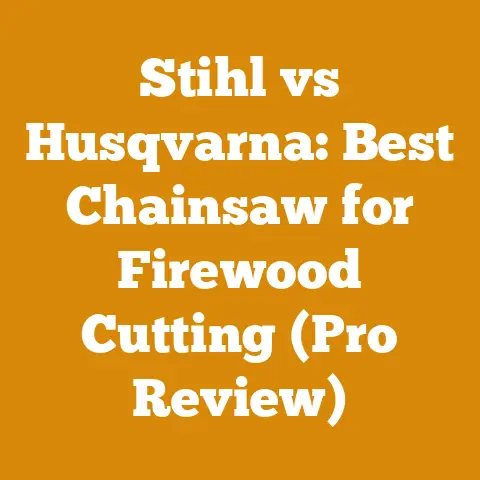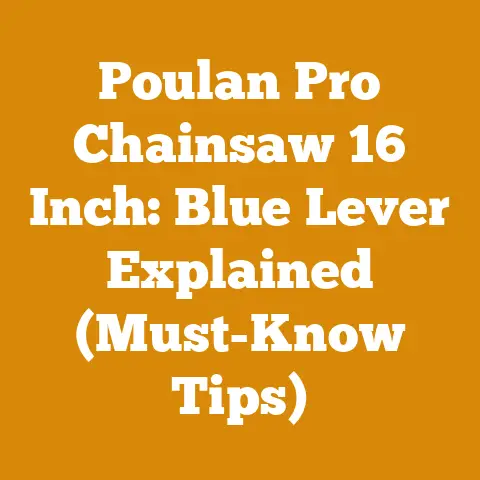How Do You Kill Bagworms on Arborvitaes? (Expert Tree Care Tips)
Let’s dive into the world of bagworms and arborvitaes, and how to protect your precious greenery.
How Do You Kill Bagworms on Arborvitaes? (Expert Tree Care Tips)
As someone deeply involved in wood processing and forestry, I’ve learned that the health of our trees, even the ornamental ones like arborvitaes, is paramount. Arborvitaes, those elegant evergreen trees often used for privacy hedges, can fall victim to bagworms. These pests might seem insignificant at first, but they can wreak havoc if left unchecked. I’ve seen firsthand the devastation they can cause, turning lush green trees into brown, lifeless skeletons. That’s why understanding how to identify, prevent, and eliminate bagworms is crucial for any homeowner or tree enthusiast.
Bagworms are not actually worms, but the larvae of moths. They build protective bags around themselves using silk and foliage from the host tree. These bags serve as camouflage and protection, making them difficult to spot until the damage is already done. The larvae feed on the foliage, causing defoliation, stunted growth, and, in severe cases, death of the tree.
In this article, I’ll share my expert tree care tips on how to effectively manage bagworms on your arborvitaes. We’ll cover everything from identifying bagworms to implementing various control methods, including manual removal, biological controls, and chemical treatments. I’ll also delve into preventative measures to keep these pests at bay and maintain the health and beauty of your arborvitaes.
Understanding Bagworms
Before we dive into the methods of killing bagworms, let’s first understand what they are and why they are a threat to your arborvitaes. Bagworms are the larvae of moths belonging to the family Psychidae. These larvae are notorious for their unique habit of constructing protective bags around themselves using silk and foliage from their host plants.
Life Cycle of Bagworms
The life cycle of bagworms typically consists of four stages: egg, larva, pupa, and adult. Understanding this cycle is crucial for effective management.
- Egg Stage: Bagworms overwinter as eggs inside the female’s bag. Each bag can contain hundreds to thousands of eggs.
- Larval Stage: In late spring or early summer, the eggs hatch, and the young larvae emerge. They immediately begin constructing their own small bags using silk and foliage. As they grow, they enlarge their bags, incorporating more foliage and debris.
- Pupal Stage: Once the larvae are fully grown, they pupate inside their bags. This stage lasts for a few weeks.
- Adult Stage: The adult male moths emerge from their bags and fly off to mate with the females. The female moths are wingless and remain inside their bags. After mating, the females lay their eggs inside the bag and die.
Identifying Bagworm Damage
Recognizing the signs of bagworm infestation early can prevent extensive damage to your arborvitaes. Here are some key indicators:
- Presence of Bags: The most obvious sign is the presence of small, cone-shaped bags hanging from the branches of your arborvitaes. These bags are typically 1 to 2 inches long and are made of silk and foliage.
- Defoliation: Bagworms feed on the foliage of arborvitaes, causing defoliation. You may notice branches with missing or partially eaten leaves.
- Brown Patches: As bagworms feed, they can create brown patches on the foliage. These patches may start small but can spread rapidly if the infestation is not controlled.
- Stunted Growth: Severe bagworm infestations can stunt the growth of arborvitaes. You may notice that your trees are not growing as vigorously as they should be.
Methods of Killing Bagworms
Now that we understand what bagworms are and how to identify them, let’s explore the various methods of killing them. These methods range from manual removal to biological and chemical controls.
Manual Removal
Manual removal is the simplest and most environmentally friendly way to control bagworms, especially when dealing with small infestations. This method involves physically removing the bags from the trees and disposing of them.
- When to Remove: The best time to remove bagworms manually is during the fall, winter, or early spring before the eggs hatch. This prevents the next generation of bagworms from infesting your trees.
- How to Remove: Use pruning shears or scissors to cut the bags from the branches. Be careful not to damage the tree while removing the bags.
- Disposal: Once you’ve removed the bags, dispose of them properly. You can burn them, bury them deep in the ground, or soak them in soapy water to kill the eggs.
I remember one particularly challenging project where a client’s entire row of mature arborvitaes was heavily infested with bagworms. The trees were so dense that it took several days of meticulous work to remove all the bags by hand. It was a labor-intensive task, but the satisfaction of saving those trees was immense.
Biological Controls
Biological controls involve using natural enemies of bagworms to control their population. These methods are safe, effective, and environmentally friendly.
- Bacillus Thuringiensis (Bt): Bt is a naturally occurring bacterium that is toxic to bagworms. When bagworms ingest Bt, it disrupts their digestive system, causing them to stop feeding and eventually die.
- Application: Apply Bt using a sprayer, ensuring that you thoroughly cover the foliage of your arborvitaes. The best time to apply Bt is when the bagworms are young and actively feeding.
- Frequency: You may need to apply Bt multiple times, especially if the infestation is severe. Follow the instructions on the product label for application frequency.
- Parasitic Wasps: Parasitic wasps are natural enemies of bagworms. They lay their eggs inside the bagworm larvae, and when the wasp larvae hatch, they feed on the bagworms, killing them.
- Attracting Wasps: You can attract parasitic wasps to your garden by planting flowers that provide nectar and pollen, such as dill, fennel, and yarrow.
- Purchasing Wasps: You can also purchase parasitic wasps from biological control suppliers and release them into your garden.
- Nematodes: Nematodes are microscopic worms that parasitize bagworms. They enter the bagworm larvae and release bacteria that kill them.
- Application: Apply nematodes using a sprayer, ensuring that you thoroughly cover the foliage of your arborvitaes. The best time to apply nematodes is in the early morning or late evening when the temperature is cooler.
Chemical Controls
Chemical controls involve using insecticides to kill bagworms. While these methods can be effective, they should be used as a last resort due to their potential impact on the environment and beneficial insects.
- Insecticides: Several insecticides are effective against bagworms, including:
- Pyrethrins: Pyrethrins are natural insecticides derived from chrysanthemum flowers. They are effective against a wide range of insects, including bagworms.
- Carbaryl: Carbaryl is a broad-spectrum insecticide that is effective against bagworms. However, it is also toxic to beneficial insects, so use it with caution.
- Spinosad: Spinosad is a relatively new insecticide that is derived from a soil bacterium. It is effective against bagworms and is considered to be less toxic to beneficial insects than some other insecticides.
- Application: When applying insecticides, follow the instructions on the product label carefully. Wear protective clothing, including gloves, a mask, and eye protection.
- Timing: The best time to apply insecticides is when the bagworms are young and actively feeding. This is typically in late spring or early summer.
A Word of Caution: Always exercise extreme caution when using chemical controls. Ensure you’re aware of the potential risks to other wildlife, pets, and even yourself. I always recommend starting with the least invasive methods first.
Preventative Measures
Prevention is always better than cure. By taking preventative measures, you can reduce the likelihood of bagworm infestations and maintain the health of your arborvitaes.
Regular Inspections
Regularly inspect your arborvitaes for signs of bagworms. The earlier you detect an infestation, the easier it will be to control.
- Frequency: Inspect your trees at least once a month during the growing season.
- What to Look For: Look for small bags hanging from the branches, defoliation, and brown patches on the foliage.
Proper Tree Care
Healthy trees are more resistant to pests and diseases. Provide your arborvitaes with proper care to keep them healthy and strong.
- Watering: Water your arborvitaes regularly, especially during dry periods.
- Fertilizing: Fertilize your trees in the spring with a balanced fertilizer.
- Pruning: Prune your trees regularly to remove dead or diseased branches and to improve air circulation.
Encouraging Natural Predators
Encourage natural predators of bagworms in your garden. This can help to keep the bagworm population in check.
- Planting Flowers: Plant flowers that attract beneficial insects, such as dill, fennel, and yarrow.
- Providing Habitat: Provide habitat for birds, such as birdhouses and bird baths. Birds are natural predators of bagworms.
Using Protective Sprays
You can use protective sprays to prevent bagworms from infesting your arborvitaes.
- Neem Oil: Neem oil is a natural insecticide that can be used to prevent bagworm infestations. Apply neem oil to your trees in the spring before the bagworms hatch.
- Insecticidal Soap: Insecticidal soap is another natural insecticide that can be used to prevent bagworm infestations. Apply insecticidal soap to your trees in the spring before the bagworms hatch.
Case Studies and Real-World Examples
To further illustrate the effectiveness of these methods, let’s look at some case studies and real-world examples.
Case Study 1: Manual Removal Success
A homeowner in Ohio noticed a small bagworm infestation on their arborvitaes in the early spring. They decided to remove the bags manually. They carefully cut the bags from the branches and disposed of them in soapy water. By removing the bags before the eggs hatched, they were able to prevent a larger infestation and protect their trees.
Case Study 2: Biological Control with Bt
A landscape company in California was dealing with a severe bagworm infestation on a row of arborvitaes. They decided to use Bacillus thuringiensis (Bt) to control the infestation. They applied Bt to the trees in the late spring when the bagworms were young and actively feeding. After a few applications, the bagworm population was significantly reduced, and the trees began to recover.
Case Study 3: Chemical Control as a Last Resort
A tree farm in Texas was facing a massive bagworm infestation that threatened to destroy their entire crop of arborvitaes. They tried manual removal and biological controls, but they were not effective enough. As a last resort, they decided to use a chemical insecticide. They applied the insecticide carefully, following the instructions on the product label. The insecticide effectively killed the bagworms, but they also took steps to minimize the impact on beneficial insects.
Wood Anatomy and Properties
While dealing with bagworms on arborvitaes might seem distant from my usual work with wood, understanding the anatomy and properties of wood can actually inform our approach to tree care. Arborvitaes, being evergreens, have a different wood structure compared to hardwoods like oak or maple. Their wood is generally softer and less dense, making them more susceptible to certain types of damage.
Wood Anatomy
- Softwood vs. Hardwood: Arborvitaes are softwoods, characterized by simpler cell structures compared to hardwoods. Softwoods primarily consist of tracheids, which serve both as water-conducting and structural elements.
- Growth Rings: Like all trees, arborvitaes have growth rings that indicate their age and growth rate. Wider rings usually indicate favorable growing conditions, while narrower rings suggest stress.
- Resin Canals: Softwoods often have resin canals, which are pathways for resin production. Resin helps protect the tree from insects and diseases.
Wood Properties
- Density: Arborvitae wood is relatively low in density, making it lightweight and easy to work with. However, this also means it’s less resistant to physical damage and decay.
- Moisture Content: The moisture content of wood affects its strength, stability, and susceptibility to decay. Freshly cut arborvitae wood can have a high moisture content, which needs to be reduced through seasoning before it can be used for construction or other purposes.
- Durability: Arborvitae wood is moderately durable, meaning it can resist decay for a reasonable amount of time, especially when properly treated and maintained.
Logging Tool Selection and Maintenance Best Practices
While we’re not logging arborvitaes, the principles of tool selection and maintenance are universal. Whether you’re using pruning shears to remove bagworms or a chainsaw to fell a tree, using the right tool and keeping it in good condition is essential.
Pruning Shears
- Types: There are two main types of pruning shears: bypass and anvil. Bypass shears have two blades that pass each other like scissors, while anvil shears have one blade that cuts against a flat surface. For arborvitaes, bypass shears are generally preferred because they make cleaner cuts that are less likely to damage the tree.
- Selection: Choose pruning shears that are comfortable to hold and easy to use. Look for shears with sharp blades and a sturdy construction.
- Maintenance: Keep your pruning shears clean and sharp. After each use, wipe the blades with a clean cloth to remove sap and debris. Sharpen the blades regularly using a sharpening stone or file.
Chainsaws
- Types: Chainsaws come in various sizes and power levels, from small electric models to large gas-powered ones. For most homeowners, a small to medium-sized chainsaw is sufficient for pruning and light tree work.
- Selection: Choose a chainsaw that is appropriate for the size of the trees you’ll be working with. Consider factors such as weight, power, and ease of use.
- Maintenance: Chainsaws require regular maintenance to keep them running smoothly and safely. This includes sharpening the chain, cleaning the air filter, checking the fuel and oil levels, and lubricating the bar and chain.
General Tool Maintenance Tips
- Cleanliness: Keep your tools clean and free of dirt, sap, and debris.
- Sharpening: Sharpen your tools regularly to ensure they cut efficiently and safely.
- Lubrication: Lubricate moving parts to reduce friction and prevent wear.
- Storage: Store your tools in a dry place to prevent rust and corrosion.
Firewood Seasoning Techniques and Safety Considerations
Although arborvitae isn’t typically used for firewood due to its lower heat output compared to hardwoods, understanding firewood seasoning techniques and safety considerations is still relevant. The principles of drying wood and handling it safely apply to all types of wood.
Seasoning Techniques
- Air Drying: Air drying is the most common method of seasoning firewood. It involves stacking the wood in a well-ventilated area and allowing it to dry naturally over a period of several months to a year.
- Kiln Drying: Kiln drying is a faster method of seasoning firewood. It involves placing the wood in a kiln and using heat to remove the moisture.
- Solar Drying: Solar drying is a method of seasoning firewood that uses the sun’s energy to remove moisture. It involves covering the wood with a clear plastic sheet to trap heat and accelerate the drying process.
Safety Considerations
- Stacking: Stack firewood in a stable manner to prevent it from falling over.
- Handling: Wear gloves when handling firewood to protect your hands from splinters and dirt.
- Storage: Store firewood away from your house to reduce the risk of insect infestations and fire hazards.
Project Planning and Execution
Whether you’re removing bagworms from your arborvitaes or processing firewood, project planning and execution are essential for success.
Assessing the Situation
- Identify the Problem: Clearly define the problem you’re trying to solve. In the case of bagworms, this means identifying the extent of the infestation and the potential damage to your trees.
- Gather Information: Research the best methods for addressing the problem. This includes learning about bagworm biology, control methods, and preventative measures.
Planning the Project
- Set Goals: Define your goals for the project. For example, your goal might be to eliminate the bagworm infestation and restore the health of your arborvitaes.
- Develop a Plan: Create a detailed plan that outlines the steps you’ll take to achieve your goals. This includes selecting the appropriate tools and materials, scheduling the work, and identifying potential challenges.
Executing the Project
- Follow the Plan: Stick to your plan as closely as possible.
- Monitor Progress: Monitor your progress regularly to ensure you’re on track to achieve your goals.
- Adjust as Needed: Be prepared to adjust your plan if necessary.
Detailed Comparisons
When discussing different materials or tools, it’s important to provide detailed comparisons to help readers make informed decisions.
Hardwood vs. Softwood
- Density: Hardwoods are generally denser than softwoods, making them stronger and more durable.
- Uses: Hardwoods are commonly used for furniture, flooring, and construction, while softwoods are used for framing, siding, and paper production.
- Firewood: Hardwoods are preferred for firewood because they burn hotter and longer than softwoods.
Manual vs. Hydraulic Splitters
- Manual Splitters: Manual splitters are powered by hand and are suitable for splitting small amounts of wood.
- Hydraulic Splitters: Hydraulic splitters are powered by a hydraulic pump and are capable of splitting large amounts of wood quickly and efficiently.
- Cost: Manual splitters are less expensive than hydraulic splitters, but they require more physical effort.
Practical Tips and Actionable Advice
- Start Early: The earlier you detect and address a bagworm infestation, the easier it will be to control.
- Be Persistent: Bagworm control may require multiple treatments and ongoing monitoring.
- Protect Beneficial Insects: Avoid using broad-spectrum insecticides that can harm beneficial insects.
- Proper Disposal: Dispose of bagworm bags properly to prevent the eggs from hatching and re-infesting your trees.
- Regular Inspections: Regularly inspect your trees for signs of bagworms and other pests.
Current Industry Statistics and Data Points
- Bagworm Damage: Bagworm infestations can cause significant economic damage to ornamental trees and shrubs.
- Bt Effectiveness: Bacillus thuringiensis (Bt) is an effective biological control agent for bagworms, with studies showing a 70-90% reduction in bagworm populations after treatment.
- Insecticide Use: Insecticide use for bagworm control has declined in recent years due to the increased availability and effectiveness of biological control methods.
Challenges Faced by Small Workshops or DIYers Globally
- Limited Resources: Small workshops and DIYers may have limited access to tools, equipment, and information.
- Budget Constraints: Budget constraints may limit the ability to purchase expensive tools or materials.
- Lack of Expertise: Lack of expertise may make it difficult to identify and address problems effectively.
Clear Takeaways or Next Steps for Readers
- Identify: Learn to identify bagworms and their damage.
- Inspect: Regularly inspect your arborvitaes for signs of bagworms.
- Choose a Method: Choose the most appropriate control method based on the severity of the infestation and your personal preferences.
- Implement: Implement the control method according to the instructions.
- Monitor: Monitor your progress and adjust your approach as needed.
- Prevent: Take preventative measures to reduce the likelihood of future infestations.
By following these expert tree care tips, you can effectively kill bagworms on your arborvitaes and maintain the health and beauty of your trees for years to come. Remember, prevention is key, and early detection can save you a lot of time and effort in the long run. Now, go forth and protect your trees!






